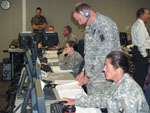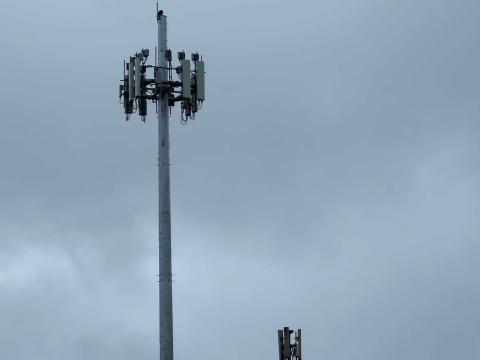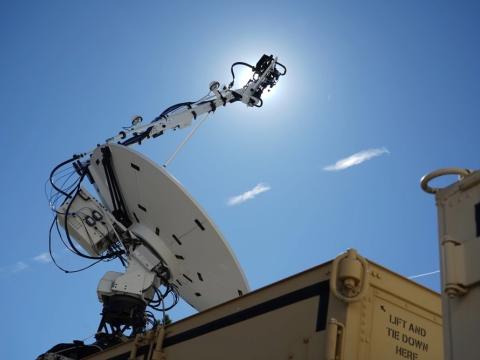Coalition Exercise Evolves With Fresh Features
 |
| The Marine Corps Command Operation Center, a regiment-size mobile communication center, was featured at Coalition Warrior Interoperability Demonstration (CWID) 2008. Personnel from the U.S. Navy and U.S. Air Force, and representatives from the United Kingdom, Australia, the Netherlands and Denmark, are examining Joint Strike Fighter technology in the center. |
The U.S. armed forces’ yearly demonstration to test and assess interoperability technologies took place in June as military services and government agencies from various countries gathered at worldwide locations to evaluate new communications capabilities. This year’s event had several new features and components, including a combatant command sponsor that filled the role for the third consecutive time, increased foreign country and direct academic participation, a focus on Afghan military operations, and a connection with other military interoperability and certification exercises. Now, personnel involved with the effort are looking to take past successes and combine them with fresh perspectives and new ideas as they prepare for the future.
The Coalition Warrior Interoperability Demonstration (CWID) is an annual event directed by the U.S. Joint Chiefs of Staff to engage cutting-edge information technology. Criteria are set by combatant commanders, and military and government agencies sponsor the participating technologies, though the developers pay their own way to take part. Since 2006, the U.S. European Command (EUCOM) has served as the combatant command sponsor, drawing on its international connections to increase involvement from NATO and other countries in its area of responsibility.
Traditionally, combatant command sponsors take up the position for only two years, but EUCOM kept control for a third year, building on its experience and adjusting for world events. According to Lt. Col. Kevin Westley, USAF, the EUCOM CWID director, the three-year term gave his command the stability necessary to investigate the coalition interoperability within its area of responsibility, especially with NATO and the United Kingdom. EUCOM was able to build on its relationships from the last two years to improve cooperation from other nations in this year’s demonstration.
Though EUCOM will relinquish the role of combatant command sponsor to U.S. Joint Forces Command (JFCOM) next year, it will continue to play a leadership role in CWID and interact with its foreign allies. This decision retains EUCOM’s expertise while bringing in new vision and priorities. JFCOM is scheduled to hold the combatant command sponsor post for two years, but the Joint Chiefs of Staff could ask the command to extend its time in the position for another year, as they did with EUCOM. For CWID 2008, JFCOM had responsibility for planning and execution oversight.
Capt. Gregory Stephens, USN, the Coalition Task Force commander and scenario working group chair for CWID, has some advice for next year’s leaders. “Start early and invite everybody,” he says. “I don’t mean that in a humorous way.” He explains that to ensure CWID success, planners need to begin their process far in advance so they can work with high-ranking officials’ schedules. They also need time to adjust if conditions or trials change and to procure adequate facilities. Early scheduling also enables the private companies demonstrating their technologies to send out their invitations sooner so they can attract potential customers.
EUCOM helped set this year’s CWID apart and improve international cooperation by increasing focus on the International Stabilization Assistance Force (ISAF) in Afghanistan. Many of the foreign participants used CWID to prepare for deployments to the Asian nation as part of that force. Planners found an area of Arizona that mimicked Afghanistan from geography and force laydown standpoints. ISAF operations were not a specific scenario in CWID, but by reproducing the conditions, troops were able to assess their technologies more accurately. “They were well-pleased with the results,” Capt. Stephens states.
 |
| Members of the Virginia National Guard’s Joint Force Headquarters participate in CWID 2008. CWID has a traditional military operations component and a homeland security/homeland defense component. |
To better echo the battlefield of today requires increased focus on joint and coalition efforts. Col. Westley shares, “The biggest area where we’ve seen the most evolvement is the increased involvement of NATO and the United Kingdom, and trying to really change the shape of how we work together.”
More than 20 multinational participants were involved in CWID 2008. All the U.S. military services also participated, including various combatant and service-specific commands, non-active-duty units, and other U.S. defense and civilian agencies. Testing took place at worldwide sites, which were connected through the
Coalition Task Force/NATO Reaction Force Network, the Coalition Task Force Network and the Homeland Security Network. Participants took part in 41 trials, each falling under one of four CWID objectives: improve coalition and joint command, control, communications, computers, intelligence, surveillance, reconnaissance architecture; improve information sharing across the full range of military operations; enhance cross-domain and multiple security level information exchange tools; and enhance government agency interoperability. CWID also offered a fifth objective—enhance integrated logistics planning tools—but no trials were entered under this category.
The biggest site for CWID was the Naval Surface Warfare Center in Dahlgren, Virginia, where personnel held 31 of the trials. This site also saw an increase in the number of international representatives, hosting foreign liaison officers from nations such as New Zealand, Denmark and Turkey. According to Col. Howard Thomas, U.S. Marine Corps CWID lead, liaisons from seven countries attended solely to see the Joint Strike Fighter trial. That demonstration involved showing the data server, electronic warfare analysis, mission deconfliction and cross-security domain data exchange capabilities of the F-35 Lightning II aircraft and the ground-based mission planning system.
Other trials of high interest were the IPv4-IPv6 Transformer, which “instantly converts IPv4-only legacy systems into dual-stack IPv4/IPv6 systems, to enable IPv6 messaging, while preserving IPv4 pass-through mode,” according to the trial summary, and the enhanced Mobile Internet Command Post (eMICP). This command post is a 53-foot trailer with office space, a conference room and a basic communications suite. The eMICP provides sheltered workspace, voice and data connectivity, and command and control capabilities on a mobile platform.
In addition to working with representatives from foreign governments, Dahlgren officials expanded their cooperation with U.S. agencies. Leadership reached out to the commonwealth of Virginia and set up an emergency operations center for CWID with the Virginia Department of Emergency Management (VDEM) in Richmond. “They’re new players,” explains Dennis Warne, Naval Surface Warfare Center Dahlgren site manager. “We’ll probably want to expand that role next year.”
VDEM and the Virginia National Guard participated only in the Homeland Security/Homeland Defense (HS/HD) trials, not the traditional military operations side, and primarily took part in the Federated Intelligence Network, VirtualAgility OPS Center and Transnational Information Sharing Coalition assessments. According to VDEM officials, each trial and demonstration they participated in successfully enhanced situational awareness and collaboration.
Beyond foreign liaisons and state responders, CWID officials at Dahlgren reached out to other military exercises for the first time this year. The Joint Users Interoperability Communications Exercise (JUICE) and one of the Department of Defense (DOD) Interoperability Communications Exercises (DICEs) overlapped CWID, so officials at Dahlgren established a JUICE/DICE node running that network next to the CWID network with the idea of creating closer ties among the events. Because the efforts are all closely related, connecting them could save time and money for groups trying to certify and field technologies. If decision makers can attend the three events simultaneously, the commands also can save money. Developers and sponsors can use CWID for discovery and assessment and then take the most promising technologies into the JUICE event. “If they do well there and can get the service or DOD support, then [officials could] take them into a DICE event and get them certified depending on which service may or may not have interest,” Col. Thomas says.
Though CWID and the other exercises ran on two separate networks that did not connect this year, officials wanted to show that collaboration among the events is possible. In the future, the path toward certification may be a quick line from demonstration to exercise to formal certification. “We have to prove we can do this,” Col. Thomas explains. They also have to prove they can run all the operations centers and that senior commanders will support them. In two or three years, this demonstration/exercise partnership could lead to transitioning capabilities from the laboratory to the field more quickly.
While the personnel at Dahlgren increased and improved their partnerships, leadership at U.S. Northern Command (NORTHCOM), which leads the HS/HD portion of CWID, worked to expand their reach and alliances as well. The homeland trials focused on internal U.S. events such as a mass evacuation from the District of Columbia and a short-range missile hitting the port in Charleston, South Carolina, but they also included incidents that would require cooperation with Canada. Besides efforts such as a search and rescue on Lake Erie that entailed communication between the two countries, the nations also used CWID as a chance to prepare for the 2010 Olympic Games in Vancouver, British Columbia.
The HS/HD trials incorporated 16 technologies, all of which performed well. “This is my fifth year as a lead and I have not had one trial this year fail,” Christopher Lambert, HS/HD CWID program lead, says. “They are all working as advertised.” He describes certain trials as having piqued particular interest, including a browser-based software solution that caught the attention of Canadian officials. It allows interoperability among agencies and enables planning, tracking and sharing of information activities.
NORTHCOM assisted EUCOM with a joint concept technical demonstration on the Transnational Information Sharing Coalition. The technology aims to change information sharing by driving collaboration toward the Web. It incorporates various open-source communities to create an outward-facing collaborative network based on Web-native architecture.
Lambert shares that another trial of particular interest was a virtual private network (VPN) on a memory stick. “That’s pretty cool,” he says. The technology enables personnel to use a computer connected to the Internet anywhere in the world, insert the memory stick into the universal serial bus (USB) port and connect back to their desktop. Lambert explains one application for the capability would be to continue normal services in the event of a pandemic influenza. Major commands, for example, would need to keep people out of the workplace, but continue their functions, and options such as providing each employee with a laptop are cost prohibitive. The VPN memory sticks would allow everyone to work from home and yet have full access to their network for minimal funding. “It’s cost saving for the command, but keeps everyone operational,” Lambert explains. As a security measure, the technology locks down the computer when it is inserted, ensuring nothing is added to or taken off the network.
Other HS/HD trials of interest were the Joint Environmental Toolkit, which is a weather service information sharing tool; the WorkFlow Manager and Brief Assembly Tool, a system that geographically dispersed teams can use to feed information into a centralized portal that manages workflow and gathers, collates and renders information into a consistent output format; and the RIOS Incident Site Communications Capability, which is a software-based tool connected to the network that allows all radios to interoperate among each other as well as with phones and computers.
One unique feature of this year’s HS/HD CWID was the direct participation of an academic institution. San Diego State University represented San Diego in the demonstration, because city personnel were swamped with the real-world events of the U.S. Open championship golf tournament and a large conference. The university’s visualization center has an operations center that could be used in the long term as a back-up operations center for the region during a catastrophe.
San Diego State’s participation came naturally, because it offers a master’s degree in homeland security and is attempting to conduct more community outreach. Bob Welty, director for homeland security for the university’s research foundation and co-director of the visualization center, explains that part of his job is to look for new interoperability technologies and technologies the university can incorporate. Another part of his job is to field questions from the first-responder community about what capabilities they should consider. “[CWID participation] is just a logical implementation of that concept,” he shares.
The university worked primarily with the Space and Naval Warfare Systems Center in San Diego. School participants established an interface with the Navy to prove how the groups could work together in a real-world event. San Diego State also had a chance to test some of the technologies developed in its laboratories.
Though San Diego and regional personnel already knew they could communicate, Welty says CWID enabled the groups to know who they needed to talk to in certain situations with reachback to NORTHCOM. He adds that the university already is working with area first responders and military. The school also worked closely with first responders before CWID to make sure they represented the city’s
resources accurately.
Welty says San Diego State absolutely plans to participate in CWID again, and the university can act as an insertion point for local technologies. Developers could demonstrate their capabilities at the school to local first responders and local military.
Even as CWID 2008 winds down, work is ramping up for next year’s event. The Federal Business Opportunities announcements already have been posted, and proposals are due October 5. Selections will be made later that month.
Web Resources
Coalition Warrior Interoperability Demonstration: www.cwid.js.mil
DOD Interoperability Communications Exercise: http://jitc.fhu.disa.mil/dice/index.html
Naval Surface Warfare Center Dahlgren: www.nswc.navy.mil
Virginia Department of Emergency Management: www.vdem.state.va.us




Comments